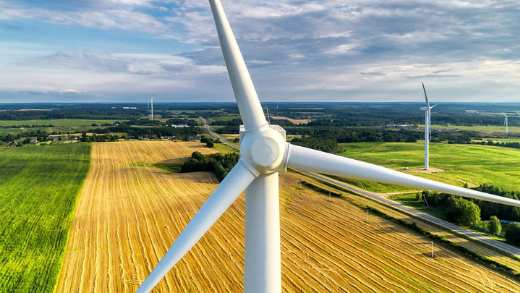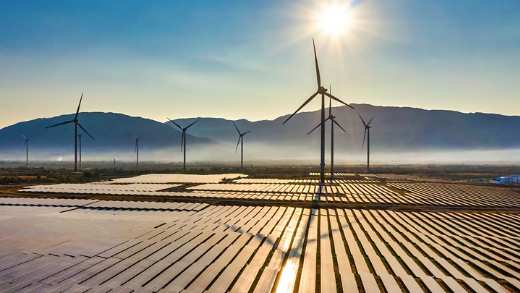Read this article to understand:
- Why marine ecosystems matter
- Ten ways in which human intervention is damaging ocean health
- How we can become better custodians
Just over 70 per cent of planet Earth is covered in water; billions of people are directly and indirectly dependent upon oceans for their survival.
But all is not well. The untimely death of marine life,1 repeated chemical spills2 and accumulation of ocean plastic3 are examples of threats already undermining the food, jobs and environmental services oceans provide.
Here, we set out ten human-induced challenges for marine ecosystems, and ask what steps need to be taken to ensure these essential systems retain their vitality.
Mass extinction
“A lot of heat and carbon dioxide trapped in the Earth system as a result of human activity is being absorbed by the oceans, with potentially devastating consequences,” says Rick Stathers, Aviva Investors’ climate lead. “The oceans are warming and acidifying, which scientists say could contribute to the greatest extinction of marine life for 250 million years.”
Figure 1: Could climate warming trigger another ‘Great Dying’?
Marine species

Land mammals

Note: Known species loss in Permian-Triassic extinction.
Source: Aviva Investors, June 2022. Original data sourced from National Geographic, September 20194
Next?
Energy systems change to maintain temperature increase to below two degrees Celsius above industrial average,5 decarbonisation, focus on energy efficiency.
Changing thermohaline circulation
The thermohaline circulation represents how water circulates through the world’s oceans, carrying heat from the tropics towards the poles and sending cold water back in deep ocean currents.6 There are fears warmer global temperatures could disrupt the circulation, shifting the production of plankton that underpins ocean food chains and threatening established fishing grounds.
Figure 2: The great ocean conveyor belt

Source: Aviva Investors, June 2022. Original data sourced from Inside Climate News, February 25, 20217
Next?
Energy transition, adaptation in fishing zones and species targeted by fisheries.
Hazardous chemicals
The ocean is critical for life on Earth, so it seems extraordinary there have been no major studies on the extent of marine chemical pollution, including persistent chemicals that linger, and their biodiversity impacts.
“There are material risks the chemical sector generates, and material risks the industry faces from a transition to a zero-pollution ocean. Companies need to focus on these now,” says Eugenie Mathieu, Aviva Investors’ Earth lead and senior impact analyst.
Figure 3: A chemical explosion

Source: Aviva Investors, June 2022. Original data sourced from Back to Blue, 20228
Next?
Greater transparency about substances of “very high concern”; stricter regulation of chemical pollution from specialty chemicals, pharmaceuticals and agricultural producers; evolution of ‘green chemistry’.
Fertilisers
Extensive areas of ocean are now ‘dead’ or hypoxic, where the water contains too little oxygen to support life. Fertiliser-enriched run-off from agriculture and wastewater can cause algae to overgrow, stifling opportunities for other lifeforms.
Figure 4: Low-oxygen dead zones

Source: Aviva Investors, June 2022. Original data sourced from Back to Blue, 20229
Next?
Precision agriculture, greater attention to land and wastewater management.
Desalination plants generating super-saline brine
As human populations have pushed into arid areas, demand for potable water has grown. Desalination plants use reverse osmosis to separate water molecules from seawater but produce super-saline brine as waste, which has negative environmental impacts when discharged. Recent research suggests brine production is about 142 million m³/day, about 50 per cent higher than previously thought.10
Figure 5: Desalination - solution and environmental challenge

Note: Daily super-saline brine output.
Source: Aviva Investors, June 2022. Original data sourced from Science of The Total Environment, March 201911
Next?
Improving brine management strategies to limit negative environmental impacts and safeguard water supplies.
Overfishing
Around one billion people rely on fish as a primary source of protein, but overfishing is driving many marine species towards extinction. Destructive practises like bottom trawling are still taking place in marine protected areas.12
Unintentional catch – bycatch – ends the life of millions of marine dwellers early every year. According to the International Union for Conservation of Nature, 99 per cent of sharks and rays are threatened by this inadvertent culling.13
Figure 6: The marine cost of bycatch

Source: Aviva Investors, June 2022. Original data sourced from Reef Conservation International, February 201814
Next?
Science-based limits on fishing, effective monitoring of marine protected areas using new approaches like artificial intelligence to track unauthorised activity, and approaches that reduce or eliminate fishing mortality.
Plastic
Humans have created a gigantic 9.2 billion metric tonnes of plastic,15 more than any other material apart from steel and cement. The plastic washed into the oceans can entangle marine species or be ingested, leading to the death of around one million seabirds, 100,000 sea mammals and countless turtles and fish every year. Without changing our ways, ocean plastic might outweigh fish within three decades.16
Figure 7: Plastic – getting the measure

Source: Aviva Investors, June 2022. Original data sourced from The Conversation, February 202217
Next?
Enforcement of a legally binding global treaty on plastic pollution promised by 2024, described by UN Environment Program executive director Inger Andersen as “an insurance policy for this generation and future ones, so they may live with plastic and not be doomed by it”.18 Better waste management and recycling and development of bio-alternatives are also crucial.
Oil spills
The volume of oil spilt because of human error has decreased significantly since the 1970s, but spills are not unusual.
An event off the coast of Peru reported to have lasted “minutes” affected 106 square kilometres of ocean in 2022,19 killing fish and seabirds in a wide-ranging environmental catastrophe.
Figure 8: Large and medium spills (1970s-2021)
Source: Aviva Investors, June 2022. Original data sourced from ITOPF, 202120
Next?
Focus on reducing leaks and blowouts, improving physical containment, and accelerate the energy transition.
Ocean mining
Geologists are searching on the seabed for valuable transition metals to mine. Nodules rich in nickel, copper and cobalt have been found on the ocean floor,21 along with sediments containing rare earths like lanthanum and neodymium.22
“This a key interface of the debate about actions to mitigate climate warming,” says Mathieu. “To mine transition metals, are we prepared to damage ocean ecosystems?”
Figure 9: Assessing deep sea mining impacts

Source: Aviva Investors, June 2022. Original data sourced from IUCN, 202223
Next?
More research.
“There are a zillion reasons not to mine the sea floor, and fewer reasons to mine the sea floor. We still know so little. We have so much work to do before we can get there.”
John Jamieson, Canada Research Chair in Marine Geology24
Construction of coastal flood defences
About 600 million people around the world live at risk of coastal flooding. Demand for protection is expected to grow as extreme weather events increase and sea levels rise. Building engineered structures (e.g. ‘grey’ protection like levees, requiring fuel, ground work and construction) can be financially and environmentally costly, disturbing coastal habitats and modifying water chemistry.
Figure 10: Frequency of flooding in low-lying coastal cities and small islands
Once every 100 years

Every year

Source: Aviva Investors, June 2022. Original data sourced from Intergovernmental Panel on Climate Change, 201925
Next?
Hybrid coastal protection incorporating grey and green protection (for example, maintaining seagrass beds, mangroves, reefs) for more sustainable flood solutions.



















